Pruning Pains
Their abundant summery wordage silenced, caught
In the grim undertow; naked the trees confront
Implacable winter’s long, cross-questioning brunt.
– D. H. Lawrence, Winter in the Boulevard, 1916
It’s February and it’s cold. And, like every February, it’s time to start pruning our apple trees, a sometimes harsh, but important task when, cold be damned, the work must go on. So, in preparation for another frozen morning in the orchard, I don multiple layers of warm clothing, pull the wool cap low over my ears, tighten my insulated work gloves and reluctantly step outside to once again confront “winter’s long, cross-questioning brunt.”
Tree pruning is one of the more crucial annual tasks we undertake each winter. A well-trimmed tree not only yields higher-quality fruit in greater abundance but also has a lower susceptibility to significant outbreaks of fungal diseases. A properly pruned apple tree opens up the interior to greater sun and wind penetration, allowing the tree to dry quickly on dewy mornings. This aids in reducing the proliferation of mold and fungus which would normally thrive in such a favorably moist environment. Increased sunlight exposure is also an important factor in promoting bud development and aiding fruit ripening and coloration.
Another important objective of pruning is to create a strong structural framework to support full fruit production. Many apple trees have a natural tendency to produce limbs that grow in a very upright position making them more susceptible to breakage under a significant fruit load. Through selective cutting, the pruner will mold the tree into a shape which reduces breakage and improves the tree’s capacity to bear a heavy load of apples.
Pruning is indeed a very essential task for orchard health and undeniably one of my most important responsibilities as an orchardist. Even with the acceptance of this knowledge, however, I never look forward to this stressful undertaking.
I have written before about this aversion I have to pruning. Now, don’t get me wrong; I love what I do but, in all honesty, I have always had a particular antipathy to this part of my job. For me, winter pruning is an experience in extreme physical discomfort. It’s the coldest time of the year as I stand alone against the icy chill, methodically (and sometimes mindlessly) clipping branches that collect at the bottom of the tree like discarded, dry bones. The tangle of unpruned branches overhead seems dense and inexhaustible and I have a growing sense of futility with my efforts. Pruning, after all, is really just a process of rejuvenation. Almost every cut I make now will be replaced with a new flush of growth in the summer. So, I will most certainly be back here next February repeating this unending ritual, once again dropping “bones” to the ground and complaining about the cold. But, as ever, the cold be damned, the work must go on…
Somehow, though, in the end, the work has its simple rewards. This I experience in that special moment when I finish pruning a tree. I stand back and gaze upward into its newly-sculpted form, marveling at its easy simplicity, admiring the clean, gray branches shorn of excess growth. It’s a physical transformation writ large. The once shaggy, overgrown tree is now a greatly slimmed-down version, tight and trim and very healthy looking. It’s a picture of abundance and fertility, where even on a gray and somber winter afternoon, it’s easy to envision those stout branches heavy with summer fruit. I like it.
This is the small recompense for my labors on those hard days when I would rather do anything except prune trees. It’s that enduring vision of richness and abundance. It’s the knowledge my efforts will ensure the long-term health and vitality of my trees which, in turn, will return the favor by filling my baskets with clean, sweet fruit in a few months. It’s a mutually beneficial relationship, a grower’s version of the Golden Rule, if you will. “Do unto others…” I take care of my trees and they take care of me.
And so, for the sake of my trees, I persevere, confronting the cold and discomfort, ignoring the numbed fingers because this is my job. This is my responsibility. This is what I have to do.
It will take weeks to complete our pruning duties. There will be many weather delays and other diversions that will distract us from our chores. We have several hundred mature trees to attend to and, in all likelihood, many of them will go unpruned this year. After all, with just a staff of two (my wife, Suzanne, and myself!), we’ll consider ourselves lucky to complete half of the trees! We are both slowed by issues of our increasing age and I battle the physical limitations imposed upon me by my Parkinson’s disease but we try very hard to not let these constraints deter us from the important work at hand. These trees are our “children” and, like all good, responsible parents, we will do our very best to attend to their every need.
What I share regarding my personal difficulties with some aspects of my work are really not all that unique. Everybody who works for a living could easily have some legitimate complaints about their own jobs. I would daresay that many other farmers and orchardists could share similar experiences of fatigue and frustration in their labors. It’s just the nature of the work in a profession where one is at the mercy of forces of nature. So, when you visit your local Farmers’ Market this summer and marvel at all the gorgeous, locally-grown produce on display, take a moment to reflect on your good fortune. Take time to appreciate what farmers and growers often endure in order to bring fresh food to your supper table. Take time to thank a farmer.
Be well and healthy.



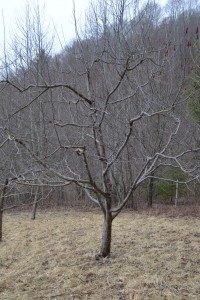
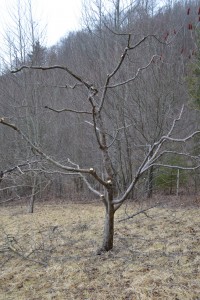
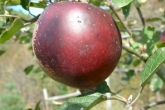
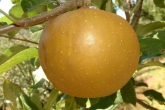
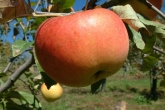
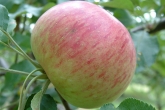








Very nicely written. I too have been afflicted with physical challenges. I ,too struggle with the necessary pruning process of having a productive tree. I sometimes feel as though I am going through a pruning process with my spinal cuts–I hope to finish my life producing some sort of goodness. Thanks for your encouraging words.
When I receive the two trees that you are grafting for me they will join a small collection of grafted trees in my small orchard (40 trees). I will favor those above mine ,and be reminded of ALL your efforts!!
Rick.